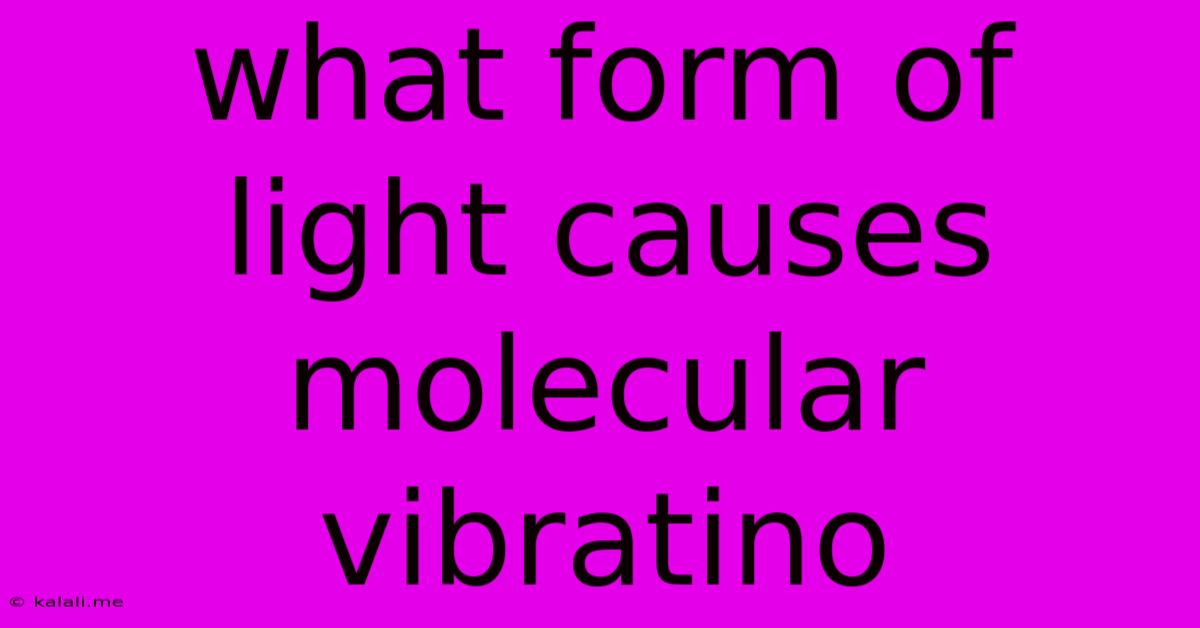What Form Of Light Causes Molecular Vibratino
Kalali
Jun 06, 2025 · 3 min read

Table of Contents
What Form of Light Causes Molecular Vibration?
Meta Description: Infrared (IR) light is the primary form of electromagnetic radiation that causes molecular vibrations. This article explores the mechanism behind this interaction, the different vibrational modes, and the applications of this phenomenon in various scientific fields.
Understanding how light interacts with molecules is fundamental to many scientific disciplines. While visible light might be the most familiar, it's infrared (IR) light that plays a crucial role in exciting molecular vibrations. This article delves into the relationship between infrared radiation and molecular vibrations, explaining the underlying physics and highlighting its importance in spectroscopy and other fields.
The Electromagnetic Spectrum and Molecular Energy Levels
The electromagnetic spectrum encompasses a vast range of wavelengths and frequencies, including radio waves, microwaves, infrared radiation, visible light, ultraviolet light, X-rays, and gamma rays. Each type of radiation carries a specific amount of energy, directly proportional to its frequency (and inversely proportional to its wavelength). Molecules possess various energy levels, including electronic, vibrational, and rotational energy levels.
Infrared Spectroscopy: A Window into Molecular Vibrations
Infrared spectroscopy is a powerful technique that exploits the interaction between infrared light and molecular vibrations. Molecules are constantly vibrating, with atoms oscillating around their equilibrium positions. These vibrations occur at specific frequencies, depending on the molecule's structure, bond strengths, and atomic masses.
Infrared light, with its specific energy levels, can interact with these molecular vibrations through a process called absorption. When an IR photon's energy matches the energy difference between two vibrational energy levels of a molecule, the molecule absorbs the photon, transitioning to a higher vibrational state. This absorption is detected by an infrared spectrometer, creating an infrared spectrum – a unique fingerprint for each molecule.
Types of Molecular Vibrations
Molecules can exhibit various vibrational modes, including:
- Stretching: Atoms move along the bond axis, either towards or away from each other.
- Bending: Atoms move perpendicular to the bond axis, changing the bond angle. This includes scissoring, rocking, wagging, and twisting motions.
The number and types of vibrational modes a molecule can exhibit depend on its degrees of freedom and symmetry. Larger, more complex molecules have a greater number of vibrational modes.
Selection Rules and IR Activity
Not all vibrational modes are IR active; that is, not all modes can absorb infrared radiation. Selection rules dictate which vibrational modes will result in a change in the molecule's dipole moment. Only vibrations that cause a change in the dipole moment can interact with the oscillating electric field of the IR light and absorb the radiation. Symmetrical molecules, for example, may have vibrations that are not IR active.
Applications of IR Spectroscopy
The ability of IR light to induce molecular vibrations has numerous applications across various scientific fields:
- Chemical analysis: Identifying unknown compounds based on their unique IR spectra.
- Quality control: Ensuring the purity and consistency of materials in manufacturing processes.
- Environmental monitoring: Detecting pollutants in air and water samples.
- Medical diagnostics: Analyzing biological samples to diagnose diseases.
- Forensic science: Analyzing evidence to solve crimes.
Conclusion
Infrared light is the key form of electromagnetic radiation that drives molecular vibrations. The interaction between IR light and molecules is a powerful tool used extensively in various fields to analyze molecular structure, composition, and properties. Understanding this fundamental interaction continues to be crucial for advancements in chemistry, physics, biology, and many other scientific disciplines. The specificity of IR absorption, coupled with the development of sophisticated instrumentation, ensures the continued importance of infrared spectroscopy in modern scientific research and applications.
Latest Posts
Latest Posts
-
The Great I Am Bible Verse
Jun 06, 2025
-
Expected Value Of Function Of Random Variable
Jun 06, 2025
-
How Can Physics Majors Get Into Quant Finance
Jun 06, 2025
-
Can You Eat The Seeds Of Bell Peppers
Jun 06, 2025
-
What Is A Substitute For Corn Flour
Jun 06, 2025
Related Post
Thank you for visiting our website which covers about What Form Of Light Causes Molecular Vibratino . We hope the information provided has been useful to you. Feel free to contact us if you have any questions or need further assistance. See you next time and don't miss to bookmark.